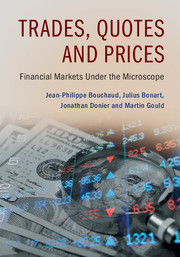Book contents
- Frontmatter
- Dedication
- Contents
- Preface
- Acknowledgements
- PART I HOW AND WHY DO PRICES MOVE?
- PART II LIMIT ORDER BOOKS: INTRODUCTION
- PART III LIMIT ORDER BOOKS: MODELS
- PART IV CLUSTERING AND CORRELATIONS
- PART V PRICE IMPACT
- PART VI MARKET DYNAMICS AT THE MICRO-SCALE
- PART VII ADVERSE SELECTION AND LIQUIDITY PROVISION
- PART VIII MARKET DYNAMICS AT THE MESO-SCALE
- PART IX PRACTICAL CONSEQUENCES
- Appendix
- Index
PART I - HOW AND WHY DO PRICES MOVE?
Published online by Cambridge University Press: 26 February 2018
- Frontmatter
- Dedication
- Contents
- Preface
- Acknowledgements
- PART I HOW AND WHY DO PRICES MOVE?
- PART II LIMIT ORDER BOOKS: INTRODUCTION
- PART III LIMIT ORDER BOOKS: MODELS
- PART IV CLUSTERING AND CORRELATIONS
- PART V PRICE IMPACT
- PART VI MARKET DYNAMICS AT THE MICRO-SCALE
- PART VII ADVERSE SELECTION AND LIQUIDITY PROVISION
- PART VIII MARKET DYNAMICS AT THE MESO-SCALE
- PART IX PRACTICAL CONSEQUENCES
- Appendix
- Index
Summary
Introduction
At the heart of all financial markets lies a common ingredient: people. These people act in their best interests, given their environment and the set of rules that govern it. As we know from many other aspects of life, human behaviour is full of complexity and surprises. Therefore, understanding financial markets promises to be a long and colourful journey.
Although the actions of a single person may be difficult to predict, the beauty of statistics is that large-scale systems populated by many different people often exhibit robust regularities that transcend individual behaviours. This property appears in countless manifestations in financial markets. An important first example is the way in which different agents (and their models) interpret “information” – whatever that might be. Predicting the direction of price changes has always proven to be difficult, but one might still aim to grasp some fundamental understanding of other market properties, such as volatility or liquidity, due to the strong regularities that emerge from the diverse actions and reactions of the ensemble.
Of course, there is no good modelling without a proper understanding of a system's rules – and of what motivates agents to play the game to begin with. In this first part of the book, we will address some fundamental questions about trading in financial markets. How do modern markets operate? Who is playing the game? What are their motivations? What challenges do they face? How do they act and interact? And how does all of this affect liquidity and volatility?
In a deep-dive into continuous-time double auctions, we will emphasise the ever-evolving nature of financial markets, and will therefore underline the ever-present need for up-to-date data. We will also touch on some universalities that have transcended time periods and geographical areas – from the subtle nature of the so-called “liquidity game” to the consistent patterns that emerge from it. How does market liquidity look at a zoomed-in and zoomed-out scale? Why is it so thin? And how do market participants’ actions affect liquidity, and therefore prices?
- Type
- Chapter
- Information
- Trades, Quotes and PricesFinancial Markets Under the Microscope, pp. 1 - 4Publisher: Cambridge University PressPrint publication year: 2018



